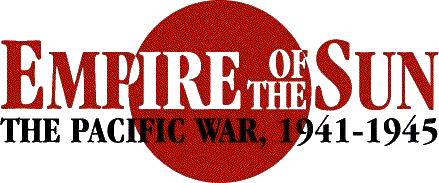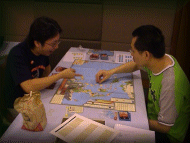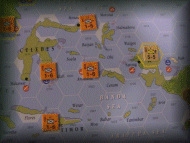|

an
after action report of GMT's card driven game of the ETO
by
Lawrence Hung
In
memory of the bombing of Hiroshima
60th anniversary, Simon and I played the 1942 scenario, which lasted 3-turns
for the whole year. The game
emphasis is on the use of Operation Cards and Event Cards to conduct
offensives. The game system is
very interactive and fluid in that the reaction player has every chance to
react with a number of units, within the range of a Headquarter, quickly to
a battle location. So you'll see
units being triggered to move at any time and thus developing small actions
into large bloody battles. Very
realistic as to what was fought over.
Air
units' Zone of Influence (ZOI) is another interesting concept not so often
seen before. The ZOI can prohibit amphibious assault, strategic movement and
tracing line of communication. The
air force is given its credit where it's due.
 Movement
allowance is dependent on the use of cards and thus its value as a
multiplier to the basic movement rate by types. Weather
is a card in your hand of fate . . . The
intelligence war is simulated elegantly. Every
battle is a surprise attack unless modified by a reaction card or a die
roll. If successful, the battle
is turned into an intercept or ambush. The
determination of intelligence state is in direct proportion to the amount of
inflicted losses. Movement
allowance is dependent on the use of cards and thus its value as a
multiplier to the basic movement rate by types. Weather
is a card in your hand of fate . . . The
intelligence war is simulated elegantly. Every
battle is a surprise attack unless modified by a reaction card or a die
roll. If successful, the battle
is turned into an intercept or ambush. The
determination of intelligence state is in direct proportion to the amount of
inflicted losses.
The
rules are well written, albeit sometimes too lengthy, but the game concepts
are generally explained well as a result. Some
rules are quite hard to understand at first e.g. Special Reaction Move vs.
Amphibious Move, Joint HQ, etc. Strangely,
naval and air units cannot attack alone on their own.
On
the
China
front, only CBI is represented in this game.
Quite a disappointment to me. Many
actions in this theatre are abstracted out simply by removing the units in
China
and thus reinforce the existing Japanese units on the map. The
China
army stays largely in
Burma
to guard the rear area of the Commonwealth or that of
China
for that matter.
 As
it seems, our game of '42 was definitely not a balanced one. The
Japanese offensives were everywhere, surrounding the Allies with massive
forces. The Battle of
Philippines becomes the focus of the game. Once
the
Philippines
had surrendered, I found the Allied helpless, especially in face of a poor
War in
Europe
die-roll. I had the Allies make
a successful counterattack on the
Marshall Islands
, but there were no victory points awarded for that. The
Dutch Indies and the resource hexes are a piece of cake for the Japanese
18-12, being garrisoned with 1-6 Dutch units. My
opponent had several political cards to influence the course of the events
in
Europe
thereby delaying the Allied reinforcements, with Turn 3 units failing to
show up at all to come to rescue the Dutch. As
it seems, our game of '42 was definitely not a balanced one. The
Japanese offensives were everywhere, surrounding the Allies with massive
forces. The Battle of
Philippines becomes the focus of the game. Once
the
Philippines
had surrendered, I found the Allied helpless, especially in face of a poor
War in
Europe
die-roll. I had the Allies make
a successful counterattack on the
Marshall Islands
, but there were no victory points awarded for that. The
Dutch Indies and the resource hexes are a piece of cake for the Japanese
18-12, being garrisoned with 1-6 Dutch units. My
opponent had several political cards to influence the course of the events
in
Europe
thereby delaying the Allied reinforcements, with Turn 3 units failing to
show up at all to come to rescue the Dutch.
We
were new to the game and thus completed the scenario in about 5 hours. With
one map and one scenario that can be played to completion in an afternoon,
we are definitely looking forward to play it again soon.
The
game ended in a Japanese automatic victory for the 1942 scenario,
controlling 11 out of the 14 resource hexes. We
had great fun with it. Victory
over defeat. What a day for the
Japanese!
back
to board gaming
|